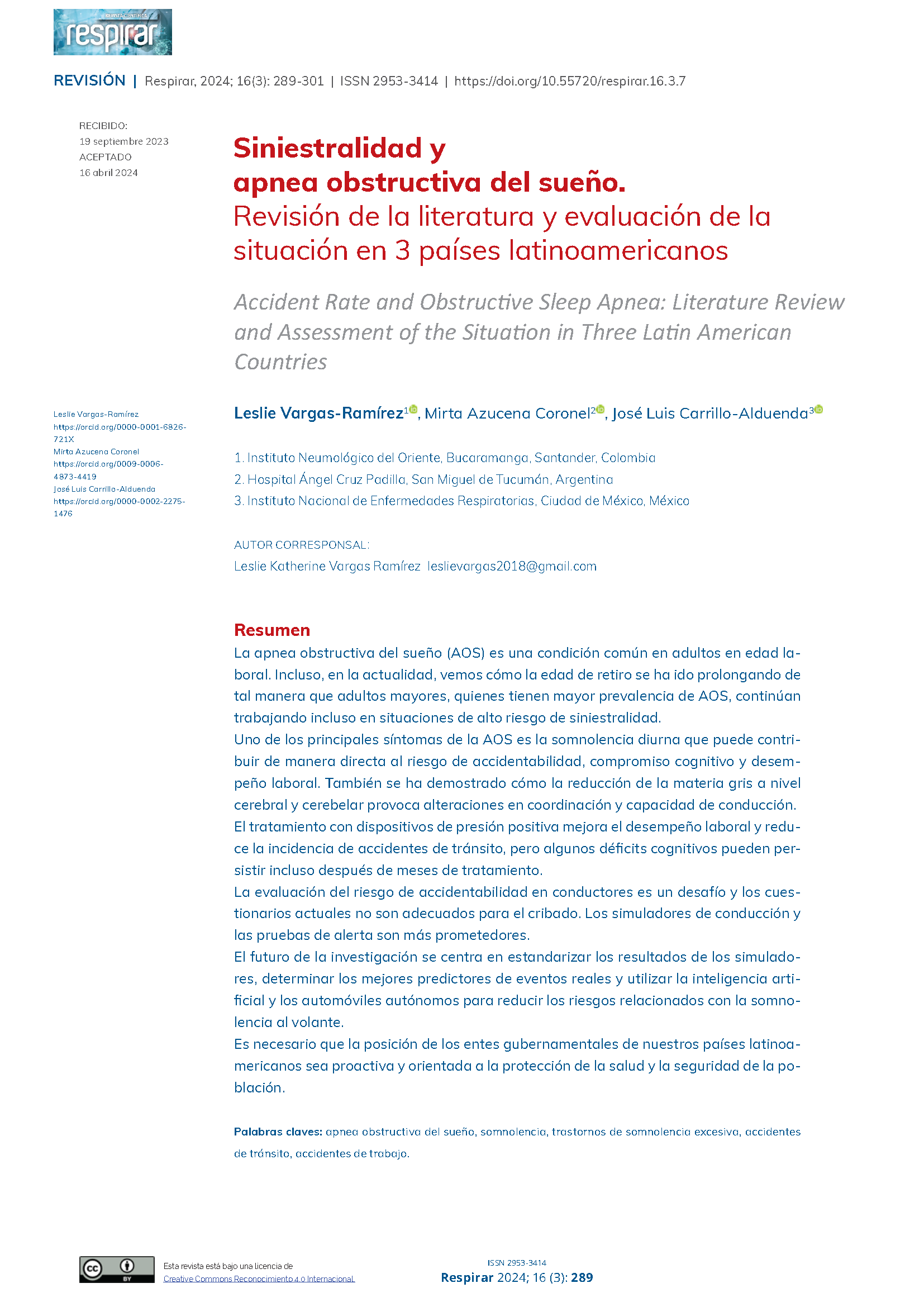Siniestralidad y apnea obstructiva del sueño. Revisión de la literatura y evaluación de la situación en 3 países latinoamericanos
Contenido principal del artículo
Resumen
La apnea obstructiva del sueño (AOS) es una condición común en adultos en edad laboral. Incluso, en la actualidad, vemos cómo la edad de retiro se ha ido prolongando de tal manera que adultos mayores, quienes tienen mayor prevalencia de AOS, continúan trabajando incluso en situaciones de alto riesgo de siniestralidad.
Uno de los principales síntomas de la AOS es la somnolencia diurna que puede contribuir de manera directa al riesgo de accidentabilidad, compromiso cognitivo y desempeño laboral. También se ha demostrado cómo la reducción de la materia gris a nivel cerebral y cerebelar provoca alteraciones en coordinación y capacidad de conducción.
El tratamiento con dispositivos de presión positiva mejora el desempeño laboral y reduce la incidencia de accidentes de tránsito, pero algunos déficits cognitivos pueden persistir incluso después de meses de tratamiento.
La evaluación del riesgo de accidentabilidad en conductores es un desafío y los cuestionarios actuales no son adecuados para el cribado. Los simuladores de conducción y las pruebas de alerta son más prometedores.
El futuro de la investigación se centra en estandarizar los resultados de los simuladores, determinar los mejores predictores de eventos reales y utilizar la inteligencia artificial y los automóviles autónomos para reducir los riesgos relacionados con la somnolencia al volante.
Es necesario que la posición de los entes gubernamentales de nuestros países latinoamericanos sea proactiva y orientada a la protección de la salud y la seguridad de la población.
Descargas
Detalles del artículo

Esta obra está bajo una licencia internacional Creative Commons Atribución 4.0.
Citas
Heinzer R, Vat S, Marques-Vidal P et al. Prevalence of sleep-disordered breathing in the general population: The HypnoLaus study. Lancet Respir Med 2015;3(4):310–8. Doi: 10.1016/S2213-2600(15)00043-0.
Morrell MJ, Jackson ML, Twigg GL et al. Changes in brain morphology in patients with obstructive sleep apnoea. Thorax 2010;65(10):908–14. Doi: 10.1016/s1389-9457(03)00159-x.
Allen AJMH, Bansback N, Ayas NT. The effect of OSA on work disability and work-related injuries. Chest 2015;147(5):1422–8. Doi: 10.1378/chest.14-1949.
Guglielmi O, Jurado-Gámez B, Gude F, Buela-Casal G. Occupational health of patients with obstructive sleep apnea syndrome: a systematic review. Sleep Breath 2015;19: 35–44. Doi: 10.1007/s11325-014-1015-8.
Morsy NE, Farrag NS, Zaki NFW et al. Obstructive sleep apnea: Personal, societal, public health, and legal implications. Rev Environ Health 2019;34: 153–69. Doi: 10.1515/reveh-2018-0068.
Uehli K, Mehta AJ, Miedinger D et al. Sleep problems and work injuries: A systematic review and meta-analysis. Sleep Med Rev 2014;18: 61–73. Doi: 10.1016/j.smrv.2013.01.004.
Ferrada X, Barrios S, Masalan P et al. Sleep duration and fatigue in construction workers: A preliminary study. Organization, Technology and Management in Construction 2021;13(2):2496–504. Doi.org/10.2478/otmcj-2021-0029
Terán-Santos J, Jiménez-Gómez A, Cordero-Guevara J. The association between sleep apnea and the risk of traffic accidents. Cooperative Group Burgos-Santander. N Engl J Med 1999;340(11):847-51. Doi: 10.1056/NEJM199903183401104.
Young T, Blustein J, Finn L, Palta M. Sleep-disordered breathing and motor vehicle accidents in a population-based sample of employed adults. Sleep 1997;20(8):608-13. Doi: 10.1093/sleep/20.8.608.
Karimi M, Hedner J, Häbel H, Nerman O, Grote L. Sleep apnea related risk of motor vehicle accidents is reduced by continuous positive airway pressure: Swedish traffic accident registry data. Sleep 2015;38(3):341–9. Doi: 10.5665/sleep.4486.
Pérez-Chada D, Videla AJ, O'Flaherty ME et al. Sleep Habits and Accident Risk Among Truck Drivers: A Cross-Sectional Study in Argentina. Sleep 2005; 28(9): 1103–1108. Doi: 10.1093/sleep/28.9.1103.
Liendo GR, Castro CL, Rey de Castro J. Cansancio y somnolencia en conductores de ómnibus interprovinciales: estudio comparativo entre formalidad e informalidad. Rev Peru Med Exp Salud Publica 2010; 27(2): 187-194.
George CFP. Sleep·5: Driving and automobile crashes in patients with obstructive sleep apnoea/hypopnoea syndrome. Thorax 2004; 59: 804–7. Doi: 10.1136/thx.2003.007187.
Vakulin A, Baulk SD, Catcheside PG et al. Driving simulator performance remains impaired in patients with severe OSA after CPAP treatment. J Clin Sleep Med 2011; 7(3):246–53. Doi: 10.5664/JCSM.1062.
Dwarakanath A, Elliott MW. Assessment of Sleepiness in Drivers: Current Methodology and Future Possibilities. Sleep Med Clin 2019; 14: 441–51. Doi: 10.1016/j.jsmc.2019.08.003.
Masa JF, Rubio M, Findley LJ. Habitually sleepy drivers have a high frequency of automobile crashes associated with respiratory disorders during sleep. Am J Respir Crit Care Med 2000;162(4 Pt 1):1407-12. Doi: 10.1164/ajrccm.162.4.9907019.
Chen L, Pivetta B, Nagappa M et al. Validation of the STOP-Bang questionnaire for screening of obstructive sleep apnea in the general population and commercial drivers: a systematic review and meta-analysis. Sleep Breath 2021;25(4):1741-1751. Doi: 10.1007/s11325-021-02299-y.
Adami A, Tonon D, Corica A et al. Poor performance of screening questionnaires for obstructive sleep apnea in male commercial drivers. Sleep Breath 2022;26(2):541–7. Doi: 10.1007/s11325-021-02414-z.
Arand D, Bonnet M, Hurwitz T, Mitler M, Rosa R, Sangal RB. The clinical use of the MSLT and MWT. Sleep 2005;28(1):123-44. Doi: 10.1093/sleep/28.1.123.
Larrateguy LD, Pais CM, Larrateguy LI, Larrateguy SD, Schlotthauer G. Simplified sleep resistance test for daytime sleepiness detection. Sleep Science 2021;14(2):164–8. Doi: 10.5935/1984-0063.20200046.
Watson NF. Health care savings: The economic value of diagnostic and therapeutic care for obstructive sleep apnea. J Clin Sleep Med 2016; 12: 1075–7. Doi: 10.5664/jcsm.6034.
